Gazzola
Found 134 Items
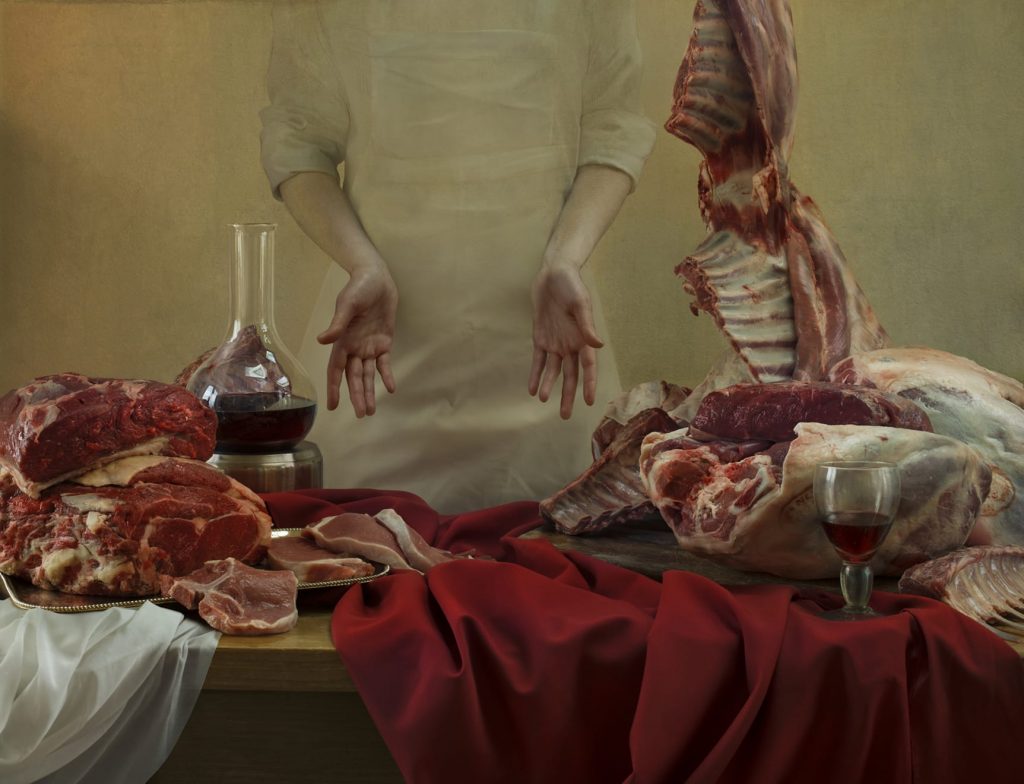
Katerina Belkina | The Dinner, 2016
February 15, 2024Katerina Belkina | The Dinner, 2016 (from the series Repast)
(Photography, Digital Painting)
“God sendeth and giveth both mouth and the meat.”
(Thomas Tusser, 1524 – 1580)
I will admit that there are certain fascinations (or perhaps less charitably or more directly classified) obsessions that ‘feed’ my interests in terms of artworks.
Meat – and how many artists employ flesh as inspiration or subject – is one of them. I offered a previous essay (centered on the fine paintings of Scott Conary) that explored this, but when I was making artworks prior to my exile or migration to Niagara (edit as you will) I often worked with fat, meat, bones and other organic matter, to make works that I described as ‘inappropriately beautiful.’
Sometimes, amidst the cacophony – or idiot choir – of ‘art criticism’ these days, with references pedantic and claiming to be ‘philosophical’ it is good to return to simply a notion of beauty. One of my best teachers, Patrick Traer – a fine artist whose work dealt with these contested, perhaps conflicting, narratives – spoke of this to me years ago, when I was still on the Prairies.
Belkina’s artwork that I share here is gripping, and perhaps inappropriately (to some weaker constitutions) beautiful. She offers some interesting ideas about her motivation and ideas that sometimes intersect with my own subjectivity, but this is an image that is striking and that, frankly, is enough.
Her religious connections are not of particular interest to me : but I must admit that my own religious upbringing (or indoctrination) have sometimes directed my interests, too – and there is a fecundity of potential interpretations that contest or converge that make her work worthy of consideration, whatever your pre existing assumptions (and I include myself in this statement).
From her site :
“Repast is an allegory of life cycles. Cyclicity perfectly characterizes humanity and our perception of time.
The Morning (childhood) means acquisition and accumulation. At the beginning of life we receive a certain foundation and potency both from our family and from the society in which we live. We learn to recognize the beauty around us and to feel it — we use all this for the rest of our lives. Even if “breakfast” is sparse in physical reality, it is often filled to the brim with intangible treasures such as love, fantasy, discoveries, strong impressions and first disappointments. In “breakfast” the abundance of dairy products is symbolic. The milk is associated with purity and virginity. The memories of breast milk are still fresh. The fullness you see is an exaggeration. The yellow of orange juice symbolizes concentrated emotions, the taste of life, sincere joy, and the energy of children. A lemon or an orange signifies the unquenchable thirst for action, knowledge, and discovery.
The Day (youth, adulthood) — creation, destruction, giving and taking. The flesh (the fruit) and the colour red are symbols of life and sacrifice. Youth is a period of expending — some build, others destroy. “Time to throw stones and gather stones” — there is a balance in this. We all make sacrifices and give everything at this point in our lives. More or less.
The Evening (age, completion) — contemplation, silence. A meditative part. Scarcity of dinner does not mean scarcity of life, or poverty. The table is set for one person. We come alone to the end of our lives, and yet we merge face to face with the divine in this world. It is a time of transition where all matter fades and loses all meaning. I believe our spirit reaches its peak here and we either accept or reject this transition completely. The set of elements depicted is simple: the fish is the symbol of Christ, the potato (the second bread) — the body losing the spirit (steam), the black tea — the drink of the gods and sages, not for simple thirst quenching, but for contemplation. The position of the hands in the triptych refers to Leonardo da Vinci’s “Last Supper”, in which the master emphasized the hands. Here they recede into the background and invite the viewer into this or that phase of life — past or future.”
Katerina Belkina was born in Samara in the southeast of European Russia : her mother was also a visual artist. Belkina attended the school for Photography of Michael Musorin in Samara and she’s exhibited her work in Moscow and Paris. In 2007 Katerina Belkina was nominated for the prestigious Kandinsky Prize (comparable to the British Turner Prize) in Moscow, and she has also been awarded the Hasselblad Masters Prize. She lives and works in Werder (Havel) near Berlin.
More of her work can be enjoyed here and here.
~ Bart Gazzola
Read More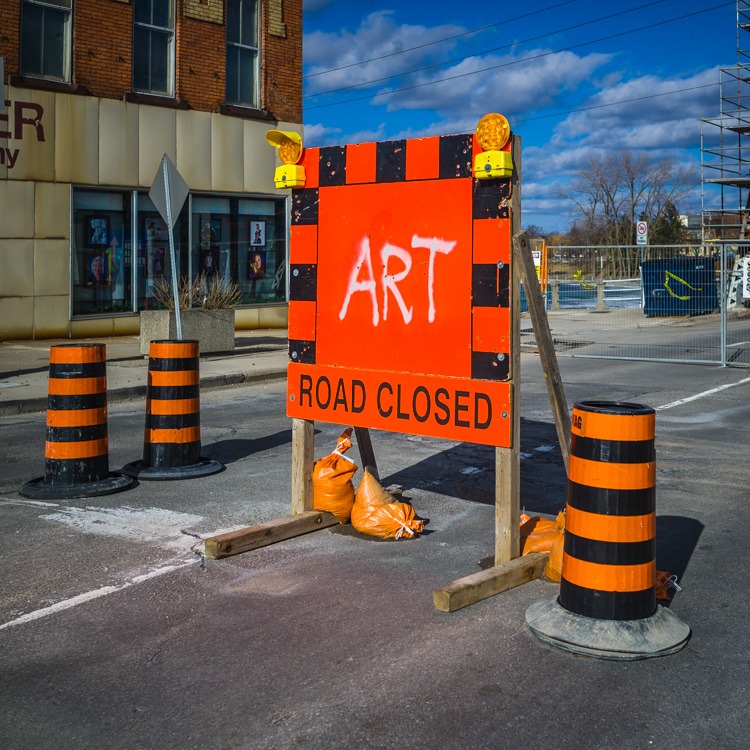
Sandy Fairbairn | ART, Road Closed | Welland, April 5 2014
January 19, 2024Sandy Fairbairn | ART, Road Closed | Welland, April 5 2014
Four years ago, just as Covid – 19 was beginning to move across the world, an exhibition of Sandy Fairbain‘s artworks that I curated at AIH Studios in Welland opened. These selections from the photographer’s extensive archive were focused upon the city of Welland and were collectively titled Welland : Times Present Times Past. Originally planned to run from February 15th to March 15th 2020, lockdowns and access became an issue, but I take joy in a local writer describing it as one of the most important exhibitions in that city, of the decade. There were also works that acknowledged the major role that Welland played in the history of labour rights in Canada, that were more sculptural, but that’s a story for another time (or seek out the book Union Power : Struggle and Solidarity in Niagara that is a fine history of the space, before we acquiesced to the ‘dogma’ of ‘trickle down economics’ and the liars Mulroney, Thatcher and Reagan, ahem).
This image was one of the more unique ones in that show, differing formally from Fairbairn’s usual straight on shots of buildings and edifices, reminiscent of ‘mug shot architecture’, if you will. But perhaps it might be better described as ‘morgue’ photos, as when we hung the show there were many captures of the same space, from decade to decade, and many times the sites were now demolished and empty….
I must add that as COVID took hold, I was in Welland for a longer time than I had planned to be there, with Fairbairn’s exhibition, and with the vagaries of lockdown I got to know the city late at night or early in the morning, a sense of itself that is not the ‘official’ kind.
Conceptually, this image offers both amusement and cynicism simultaneously. As someone who is soon to mark a decade of being part of the cultural community of Niagara, I could also add that it has resonance in terms of endeavours both planned and aborted, envisioned and stuttered, that have defined [and deformed] the cultural landscape of not just the city of Welland, but the larger Niagara Region.
So like any fine artwork, my interpretation of it changes depending upon when I see it, and the experiences I bring to it, and thus it shifts just as I do (perhaps in tandem, perhaps in opposition). To flip back to a more literal meaning from a conceptual one, my own attitudes about art initiatives within the space of Niagara have also changed, and spurred my decision to feature this work.
One hopes and works to foster artistic and cultural initiatives but finds the road closed, if you will. There are a variety of talks about ‘cultural revitalization plans’ in Niagara, but as this is the space that let a nationally recognized public art gallery go, with barely a whimper and now ignorant celebration of the ’boutique hotel’ that has taken it’s place, I shall reserve my enthusiasm…..but, to offer a positive point as we end, the push to have an Art Gallery of Welland is also moving forward, slowly but surely, and that effort is not without reward. As Sandy Fairbairn grew up in Welland (oh, the stories he’s shared with me, that I enjoy and enlivened some of his images from the aforementioned AIH exhibition), that is a space that might, soon, host more of his photographs like this one.
Not all roads are closed forever.
More of Sandy Fairbairn’s work can be seen here and here.
~ Bart Gazzola
Read More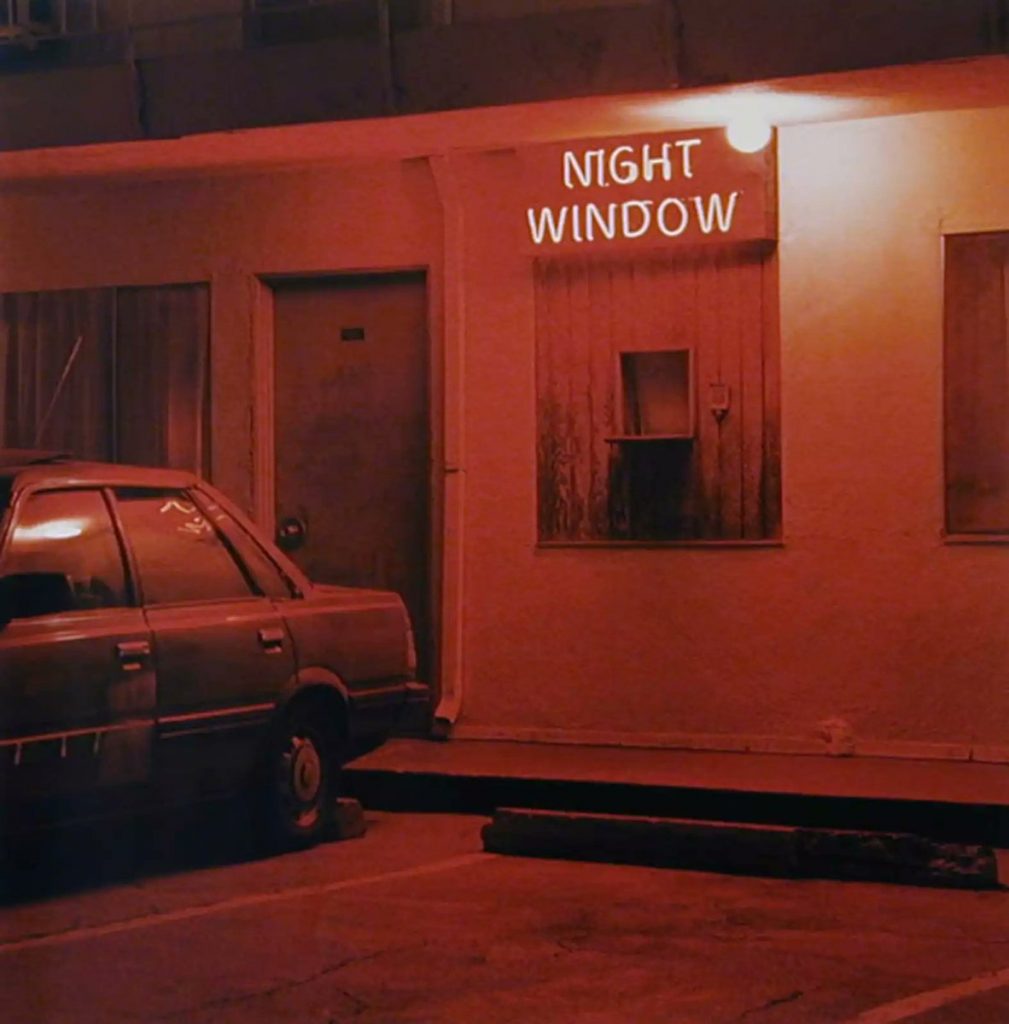
Jeff Brouws | Night Window, Los Angeles, California, 2000
December 29, 2023Jeff Brouws | Night Window, Los Angeles, California, 2000
In the Far West, where Brigham Young ended up and I started from, they tell stories about hoop snakes.
When a hoop snake wants to get somewhere—whether because the hoop snake is after something, or because something is after the hoop snake—it takes its tail (which may or may not have rattles on it) into its mouth, thus forming itself into a hoop, and rolls.
Jehovah enjoined snakes to crawl on their belly in the dust, but Jehovah was an Easterner. Rolling along, bowling along, is a lot quicker and more satisfying than crawling. But, for the hoop snakes with rattles, there is a drawback. They are venomous snakes, and when they bite their own tail they die, in awful agony, of snakebite. All progress has these hitches. I don’t know what the moral is. It may be in the end safest to lie perfectly still without even crawling. Indeed it’s certain that we shall all do so in the end, which has nothing else after it. But then no tracks are left in the dust, no lines drawn; the dark and stormy nights are all one with the sweet bright days, this moment of June—and you might as well never have lived at all.
(Ursula K. Le Guin, from her essay It was a dark and stormy nigh ; or, why are we huddling about the campfire?, 1979)
A number of the images that I share in the main page for this post are also from Brouws’ American West series (1990 – 1993) and the Highway | Approaching Nowhere series. Many of Brouws’ series seem to bleed into each other, or one body of work grows into the next in a manner that does not so much interrupt his ideas as expand them.
I have a certain affinity for abandoned and derelict spaces. I do live in the rust belt wonderland of Niagara, and before that a similar zone in Windsor and Detroit (hence my appreciation of Dave Jordano‘s fine photographs), and my time on the Canadian prairies (with ghost towns in ‘next year’s country’, as captured eerily and evocatively by Danny Singer, for example) fed that interest in an overlapping manner. Brouws’ aesthetic is akin to some past Curator’s Picks I’ve featured : The Great Texas Road Story perhaps being the most immediately similar. But Brouws’ works are less despairing, with the frequency of the neon inviting glow amidst the wastelands, but like many other artists whose work I’ve featured, historical and social themes and concerns are informed by, and informing, his scenes.
“Feelings of isolation colour my photographs – that’s what you’re sensing. It’s fascinating: what’s in your mind, heart and soul gets telegraphed onto the film plane and embedded in the photograph. It can’t be avoided.”
From the Robert Koch Gallery :
“Jeff Brouws photographically explores the American cultural landscape in its myriad of facets. A self-described “visual anthropologist” with a camera, Jeff Brouws utilizes a constructed narrative and typological approach in the making of his work. Over a span of thirty plus years, Brouws has employed a diversity of themes in his work: the American highway, the franchised landscape, deindustrialized inner city zones, as well as riffing on and re-examining bodies of work by luminary artists such as Ed Ruscha, and Bernd and Hilla Becher. Brouws captures the unique cultural experience of Americana and its iconography, visually documenting a vibrant travelogue through the half-experienced, half-remembered landscape of America’s fading culture. Directing his lens toward these temporary obsolete and abandoned sites of American consciousness, he powerfully transforms images of history and dereliction into contemplative and at times humorous commentary on the collective and expressive experience of the American landscape.”
An insightful conversation with the artist can be enjoyed here. When I first encountered Brouws’ work – the primary image in this essay Night Window, Los Angeles, California, 2000 – the quote from Le Guin that opens this meditation on his work came immediately to mind. It’s all about telling stories, some of which are quieter than others, some of which are on the verge of being forgotten and some that we may never have considered. The term ‘into the west’ has connotations both positive and negative, but that is just life, and history, and Brouws’ images encapsulate all these contradictions with an eye for beauty in what might be banal, but definitely resonates with the viewer on multiple levels.
~ Bart Gazzola
Read More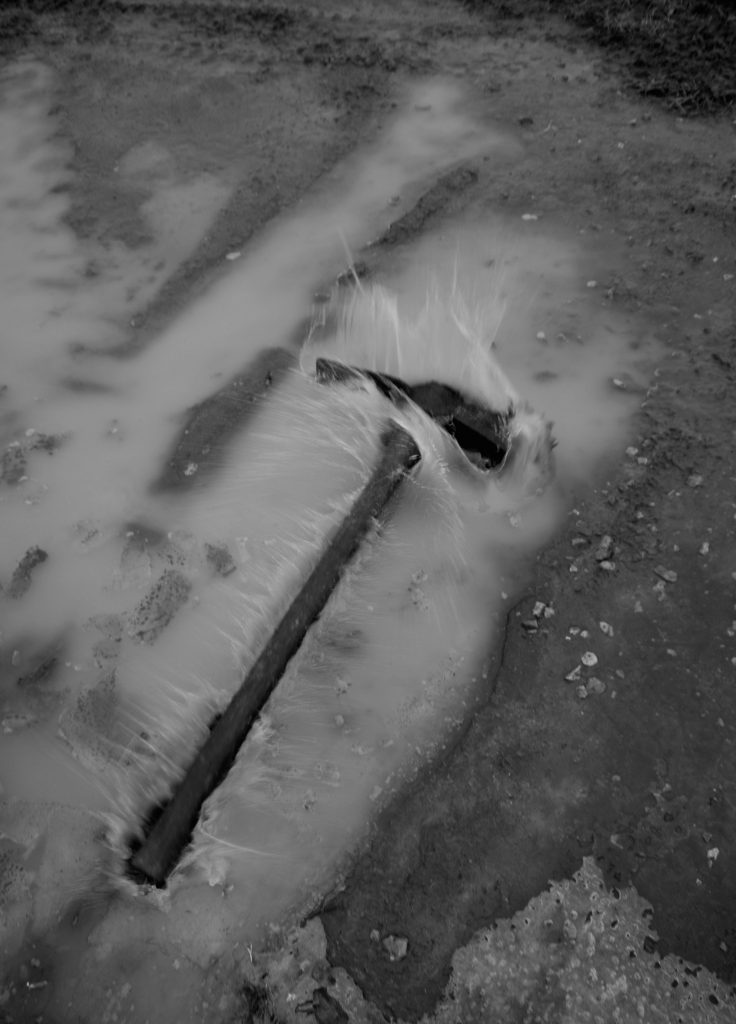
Adrianna Ault & Raymond Meeks | Ohio Farm Auction
December 11, 2023Adrianna Ault & Raymond Meeks | Ohio Farm Auction
The crops we grew last summer weren’t enough to pay the loans
Couldn’t buy the seed to plant this spring and the Farmers’ Bank foreclosed
Called my old friend Schepman up, to auction off the land
He said, “John it’s just my job and I hope you understand”
Hey, calling it your job ol’ hoss, sure don’t make it right
But if you want me to I’ll say a prayer for your soul tonight
(John Mellencamp, Rain on the Scarecrow)
One generation passeth away, and another generation cometh: but the earth abideth for ever. (Ecclesiastes 1:4, KJV)
There’s a memento mori quality to the scenes from the Ohio Farm Auction series. This may be an interpretation informed by several of the other bodies of work by Adrianna Ault (such as her series Levee which led me to the collaborative Ohio Farm Auction series), that are permeated by a sense of mortality and remembrance, as expressed in her writings about those images.
Though these images are not completely empty of people, the more striking and – unsurprisingly – starker moments that stay with you have no figures within them, though their absence and implication is powerful. The line I quote above, in response to this work came to mind immediately upon seeing the Township photos. Mellencamp’s album was a series of laments for a way of life lost (perhaps taken away or relinquished), as the world moves on (this last being closest, I feel, to the artists’ position here, with a gentle consideration of family history and generational change. Township reads more about releasing than resistance..)
The biblical quote came to me in a more indirect manner. Having recently read George Stewart’s post apocalyptic book Earth Abides (from 1949, so it ages poorly, in many ways – or this is perhaps a corolary to the ‘change’ implicit in the story presented in Ohio Farm Auction, of a time to gather and a time to discard), the ideas, again, of what is lost and our – humanity’s – place in the larger narrative of the earth was a further consideration when I engaged with these photographs…
The words of Adrianna Ault, speaking of this collaboration with Meeks (one of a number they’ve done) :
“These photographs were taken one February day in a rural township in Ohio. My partner, Raymond Meeks, and I photographed and watched as all the possessions of my family’s farm was auctioned to the highest bidder. Photographing served as a testimony to the life and work of over one hundred years of farming in my family. This work was published as a collaboration with Tim Carpenter and Brad Zellar in the book Township published by TIS books and later nominated for the 2018 Kassel Fotobookfestival Award.”
That collection of words and photographs has been described as a “careful deliberation on transience and the ultimate meaning of a way of life in the Midwest.”
More of Ault’s work can be seen here and more of Meek’s work can be seen here.
~ Bart Gazzola
Read More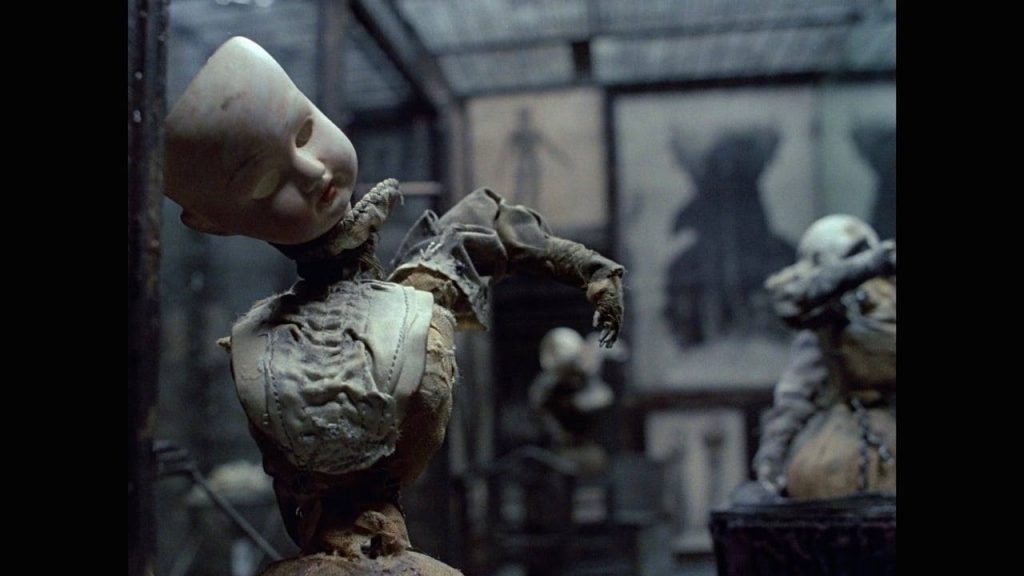
The Brothers Quay | Street of Crocodiles | 1986
November 27, 2023The Brothers Quay | Street of Crocodiles | 1986
The Street of Crocodiles was a concession of our city to modernity and metropolitan corruption. The misfortune of that area is that nothing ever succeeds there, nothing can ever reach a definite conclusion. Obviously, we were unable to afford anything better than a cardboard imitation, a photo montage cut out from last year’s mouldering newspapers. Obviously, we were unable to afford anything better.
(Bruno Schulz, The Street of Crocodiles, also known as The Cinnamon Shops, 1934)
Inspired by the short story by Bruno Schulz (The Street of Crocodiles) from a book of collected stories, Timothy and Stephen Quay – well known as The Brothers Quay or The Quay Brothers – decided that ‘rather than literally representing the childhood memoirs of Schulz, the animators [would use] the story’s mood and psychological undertones as inspiration for their own creation.’
It’s a relatively short film (approximately twenty minutes) but its brevity doesn’t prevent this work by The Brothers Quay from having a haunting impact on the viewer. There’s something about stop action animation that is unsettling, in itself (perhaps that these are ‘dolls’ that ‘pervert’ our sense of ourselves, in the manner of Hans Bellmer, dark dreams given corporeal forms) and the dark scenes (like degraded wastelands populated by equally damaged characters) where the brothers’ adaptation – or reimagination – of Schulz’ story plays out only augments this unease. Schulz’ words echo in the space : In that city of cheap human material, no instincts can flourish, no dark and unusual passions can be aroused.
Schulz (1892 – 1942) was a Jewish Polish writer, fine artist, literary critic and art teacher, considered among the great Polish – language prose stylists of the 20th century. Many of his works were ‘lost’ – as in destroyed by the nazis, the ones from the previous century – during the Holocaust, and Schulz died when shot by one of those butchers while walking home with a loaf of bread…..
I was unaware of this history when I first saw the short decades ago, but rewatching it with this knowledge only adds more dark nuance to the tableaux that the brothers have ‘built’ on the words and worlds of Schulz. The accompanying music by Leszek Jankowski is alternately jarring and mournful.
A somewhat simplistic synopsis of this work – or perhaps a banal lure to the unwary (from here) : Inside a box full of curio, a puppet who is recently freed from his strings explores a dusty and forlorn commercial area. The explorer becomes ensnared into miniature tailor shop by baby-faced dolls.
Several excerpts of Street of Crocodiles can be enjoyed here and here.
More information about the Brothers Quay – including links to many of their works – can be seen here. If you remember the film Frida (2002), you may be familiar with how the Brothers Quay are responsible for the fleeting and frightening “sequence in the film depicting the initial stages of Kahlo’s recovery at the hospital after the accident [which] are inspired by the Mexican holiday Day of the Dead.” I mention this one as the ‘doctors’ are of the same genus, perhaps, as the dolls in Street of Crocodiles…
A final word from Bruno Schulz, to end :
Our language has no definitions which would weigh, so to speak, the grade of reality, or define its suppleness. Let us say it bluntly: the misfortune of that area is that nothing ever succeeds there, nothing can ever reach a definite conclusion.
~ Bart Gazzola
Read More
Sibylle Bergemann | The Monument | 1975 – 1986
November 6, 2023Sibylle Bergemann | The Monument | 1975 – 1986
Nothing seems more improbable than what people believed when this belief has gone with the wind. (Doris Lessing)
I am old enough to remember when the Berlin Wall fell and the end of the Cold War. In a fine inversion – and something that speaks to how history is often a collaborative delusion and how, at its best, art history can be the most direct and yet most subversive form of history – I would be teaching a decade or so later and have to explain to students what both of those events were, and why they still mattered. That was also a time when I reread Doris Lessing (I recommend her award winning – and divisive, to many readers and critics – book The Good Terrorist) : I had disdain for her books when I read them in my early twenties, and was surprised at how much more sense they made to me, as I had matured and gained experiences that resonated with her words, when I was older. At that time, I was able to appreciate her words – and especially the sentiment behind them – that I quote at the start of this essay a little better….
Critic Jane Rogers (in The Guardian) described The Good Terrorist as “witty and … angry at human stupidity and destructiveness.” I must inject (as one can’t look at these images by Sibylle Bergemann and not consider the contested legacy of Marx and Engels, communism and the GDR) how I like to antagonize my christian and communist friends (not the same people, to be clear) by citing Mordecai Richler from his seminal book Solomon Gursky Was Here. In the voice of the aforementioned Gurksy, Richler avers that the system (whether the Sermon on the Mount or the Communist Manifesto) is inspired but it is humanity that is vile…
Enough tangential commentary, let’s have some facts : “From 1975 until 1986 Sibylle Bergemann accompanied the making of the huge bronze of Marx and Engels in Gummlin / Usedom from the first sketches to the installation. The work, which was created by the sculptor Ludwig Engelhardt, is still located near the Alexanderplatz in Berlin-Mitte.” There has been controversy about this monument, as Germany struggles with its past as defined in the present, whether it be the theoretical space of Marxism or that the GDR was one of the most repressive states in the 20th century. Monuments, after all, occupy both physical space and conceptual ground in any national imaginary.
In tandem with this, I’d suggest watching the ‘tragicomedy’ film Goodbye, Lenin : “the story follows a family in East Germany (GDR); the mother is dedicated to the socialist cause and falls into a coma in October 1989, shortly before the November revolution. When she awakens eight months later in June 1990, her son attempts to protect her from a fatal shock by concealing the fall of the Berlin Wall and the collapse of communism in East Germany.” A majority of that film was shot where this sculpture is located, at the Marx – Engels Forum.
First as tragedy, then as farce, ahem, someone (okay, Engels, ahem) said….
Bergemann’s words about her art and aesthetic : “I am interested in the edges of the world, not the center. The incompatible is crucial material for me. When something isn’t right about faces or landscapes that doesn’t quite fit…”
As of this writing, I am also working on an Artist You Need To Know post about the Mexican photographer Lola Álvarez Bravo (1903 – 1993). Bravo’s words also apply to Bergemann’s Monument series : “If anything is useful about my photography, it will be the sense of being a chronicle of my country.”
But I don’t approach this without bias : my stance can be seen in the primary image I’ve chosen, where the figures are ‘missing’ their heads, like a reversal of Shelley’s Ozymandius, where only the legs remain of his forgotten ‘king’….
More about this project can be seen here and more of Bergemann’s photographs can be enjoyed here.
~ Bart Gazzola
Read More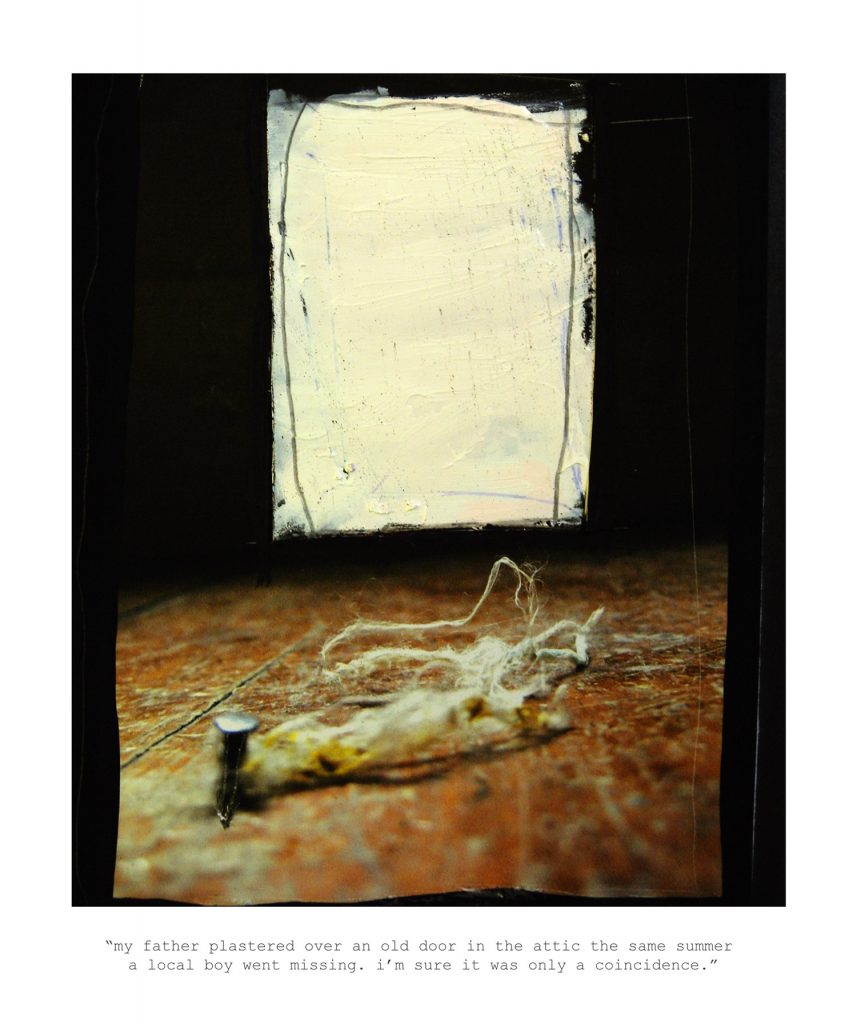
Gerald Slota | Home Sweet Home | 2010
October 30, 2023Gerald Slota | Home Sweet Home | 2010
(in collaboration with Neil LaBute)
Welcome to the midnight America, the one that exists parallel to the “real” world. It’s a dark country, one where men with hooks haunt Lover’s Lane and scarecrows walk on moonlit nights. It’s the place where people go when they slip into the cracks between light and darkness, a world of routewitches and oracles, demons and ambulomancers.
The rules are different here, and everyone’s playing for keeps. Be careful. Be cautious. And listen to the urban legends, because they may be the only things that can save you from the man who waits at the crossroads, hunting souls to keep himself alive.
Welcome to the ghostside.
Home Sweet Home is a collaboration between Gerald Slota and playwright Neil Labute. Introduced to each other in 2008, they began corresponding and working together (via email, for the most part, as they did not actually meet in person until – fittingly – an exhibition of this work in New York City in October 2010.) From the statement about Home Sweet Home : “For the first time Slota’s visual narratives are aligned alongside written narratives. The series title serves as an ironic reference to much of the early material’s dark focus on themes of home and family.”
The world that Slota and LaBute present us with is the descendant – a successor, in some ways – of the sites and landmarks from Michael Lesy’ The Wisconsin Death Trip. Denizens of a desperate world, sometimes leading lives of ‘quiet desperation’ (but not always, as secrets fester and explode, unable to be contained forever, just as some of the ‘narrators’ of these images must share what they have held inside….)
I also interpret these as postcards from the characters in Harmony Korine’s infamous film Gummo (1997) : a ‘loose narrative follows several main characters who find odd and destructive ways to pass time, interrupted by vignettes depicting other inhabitants of the town.’ That descriptor could apply to Home Sweet Home as well as Korine’s experimental film….
LaBute – whose words offer an unsettling nuance and depth to Slota’s images here – has also observed that “we humans are a fairly barbarous bunch”…..
This isn’t a new concept—the idea that stories change things, rewrite the past and rewrite reality at the same time…
The true secret of the palimpsest skin of America is that every place is different, and every place is the same. That’s the true secret of the entire world, I’d guess, but I don’t have access to the world. All I have is North America, where the coyotes sing the moon down every night, and the rattlesnakes whisper warnings through the canyons.
The true secret of the skin of America is that it’s barely covered by the legends and lies that it clothes itself in, sitting otherwise naked and exposed.
More of Gerald Slota’s work can be enjoyed here. Slota was also a recently featured Artist You Need To Know from AIH Studios’ continuing series : that can be enjoyed here.
All italicized quotes are from Seanan McGuire‘s books Sparrow Hill Road (2014) and Girl in the Green Silk Gown (2018) from her Ghost Road series. In these stories the urban legend of ‘Resurrection Mary‘ is told from the point of view of the dead girl Rose Marshall who’s been wandering the highways and back roads of a ‘secret’ United States of America since her death in 1952….
~ Bart Gazzola
Read More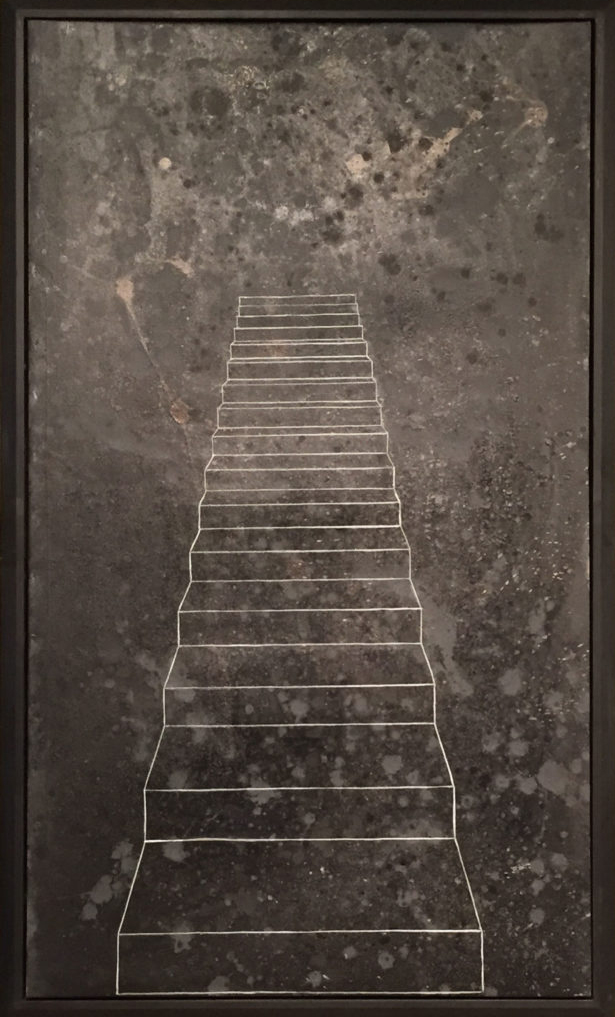
Ron Boaks | Stairway To The Heavens V | 2017
October 20, 2023Ron Boaks | Stairway To The Heavens V | 2017
There is a black which is old and a black which is fresh. Lustrous black and dull black, black in sunlight and black in shadow.
(Ad Reinhardt, from Art-as-art: The Selected Writings of Ad Reinhardt)
The dead cannot remember themselves; that’s why the living have to.
(Sarah Monette)
At the risk of getting too personal, too subjective, it’s often not a good experience to go to an art opening when you’re known in the community as an arts journalist. RM Vaughan has written about this, but there are – of course – exceptions to this rule, stepping outside the space where you have individuals attempting to bully and bleat or blow smoke up your ass, ahem.
When I was spending time in an exhibition of Ron Boaks’ painting a few years ago at a gallery in Niagara, an impromptu conversation with the artist became a high point of interaction and conversation about his work (and the larger milieu of artmaking, too).
At that time, Ron and I spoke about a body of work I colloquially refer to as the ‘Staircase’ series. These are (literally) darker works with an assortment of symbolic or metaphorical glyphs “scratched” and seemingly etched into and upon them : many of the pieces are defined by the recurring – but simple and perfect in execution – staircase. This offers an invitation to another site : not so much an ending as a transition to another place and sense of being.
Our conversation, at some point, touched upon how these were scenes Ron had created in response to the loss of loved ones : and I should clarify that they were dark in a formal sense but not in an experiential one. They had an element of hope, an injection of transcendence, perhaps, instead of a commentary on endings.
This painting that I’m featuring is from that exhibition and grouping of artworks : Boak’s Spirit Arise series.
Boaks’ words : “With this body of work, I am trying to capture “the lightness of being”, that essence of life, state of grace, of being alive right now. In 2013 two very dear people to me died. Awhile after their passing, I began to feel lighter in “spirit”, as, if they were now free, that it was OK for me to feel that too. This lightness is translated into these paintings as the energy or spirit entity, surrounded by rich colour. The paintings are grounded by the almost drafted line, measured, as it were, like distance markers on a map. X and Y coordinates are usually there, doubling as chromosomes. There are collaged bits, often as the pieces on each side edge that mark my boundaries. Balance and the interplay of opposites is as important as ever. Some of these paintings are serene and sublime while others are happy in their intensity or darkness. These are complex relationships made visible as simply as possible. These works need to be mulled over, absorbed and enjoyed.”
I would later visit Ron’s studio and we chatted about his work : I always love when artists trust me enough to invite me into their spaces, and I think that initial conversation had a role in that.
This is an image that offers a sense of what comes after death (and I say this as someone who is between an agnostic and an atheist, most days): but that which we leave behind us exists in a variety of forms, whether our experiences with others or the impressions we leave upon them, that inspire those whom remain to commemorate our passing.
Ronald Boaks’ career as an artist spans 30 + years. He has exhibited throughout Canada, the United States and the United Kingdom. His artwork has been widely collected and can be found in many public, corporate and private collections nationally and internationally.
More about his work can be seen here (Boaks was a previously featured Artist You Need To Know from AIH Studios’ continuing series) and at his site.
~ Bart Gazzola
Read More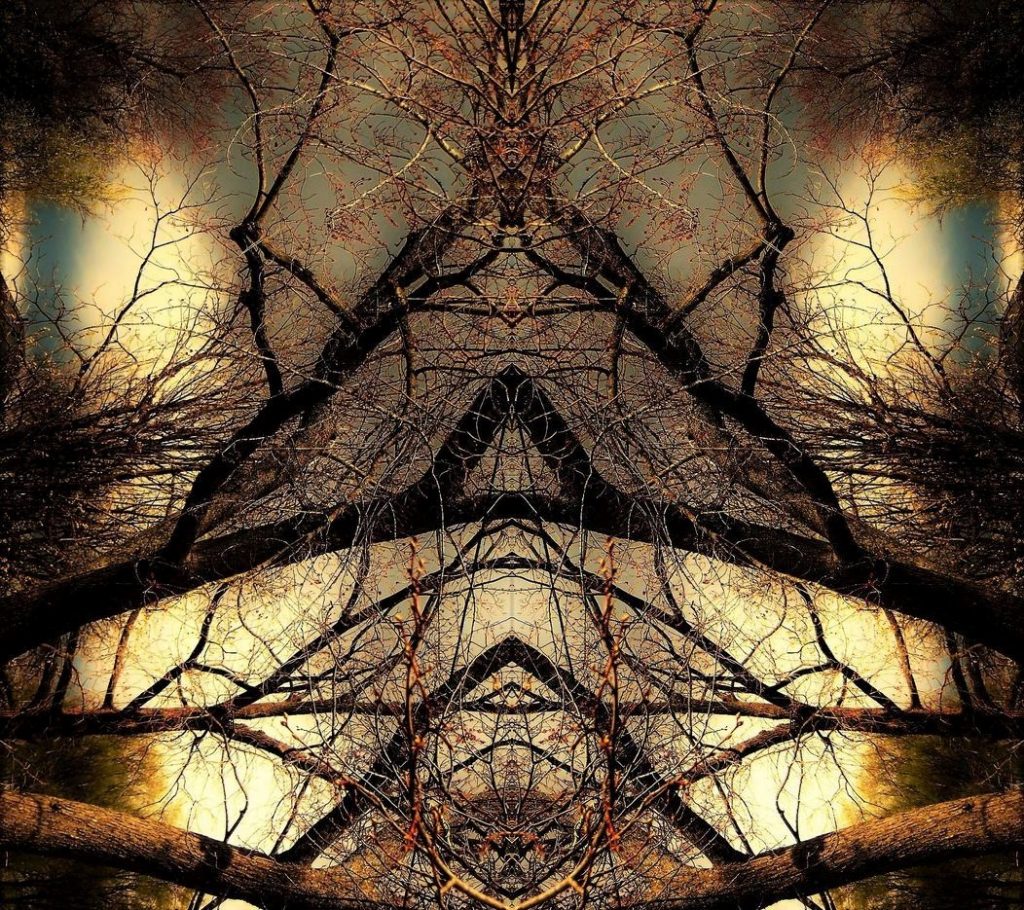
Diane Beard | Walking from the Darkness to the Light
October 2, 2023Diane Beard | Walking from the Darkness to the Light
“…life is brief and lovely, not long and foolish, that it is strange and beautiful, yeah as a dream, then so let it be, if it must be tears, if tears alone may serve…”
(Jack Kerouac)
Diane Beard is a photographer who takes pictures of her immediate community of Welland (usually while walking the streets of the city), often manipulating the images digitally to have a surreal or abstracted quality.
She was one of the featured artists in the Welland Creatives Network’ 13 on the 13th exhibition at the Welland Historical Museum in 2022. We became acquainted during COVID, when the artists’ group I facilitate – the 5 x 2 Visual Conversations – began to ‘meet’ online, and Beard was an enthusiastic and impressive participant.
Diane is the widow of artist Ross Beard (1953 – 2019) who was arguably the most significant visual artist in the history of the city of Welland. Frankly, I prefer to say ‘is’ as a recent exhibition of his work indicated that he lives on in his artwork and the joy many find within it.
His passing was – is – a fracture in her life, and part of her response has been the many images she’s produced and shared, both online and in the Niagara visual arts community.
From a recent exhibition – which was titled Walking from the Darkness to the Light – in St. Catharines : “Having been surrounded by Ross’s awe-inspiring art, sharing the same love of nature and appreciation for the Niagara area, driven by grief combined with a loss of identity after Ross’s passing, yet with no formal training, Diane began taking photographs as means to express her feelings and emotions. Diane’s sense of color and form transcends a simple mundane scene into something abstract and at times unrecognizable mimicking the profound change in her life.”
I’ve been lucky enough to talk with Diane often about her work. The contrast between a scene you recognize and something completely alien is one of the aspects of her work that’s alluring. Beard has an innate sense of colour, composition and a vibrancy in her scenes. This vivacity is an appropriate challenge to the fact that these images are, at their genesis, about loss and mourning and how to move through that….
Beard shares images regularly on social media, and is a prolific artist. I’ve only shared a small part of her body of work, and more can be enjoyed here and here.
~ Bart Gazzola
Read More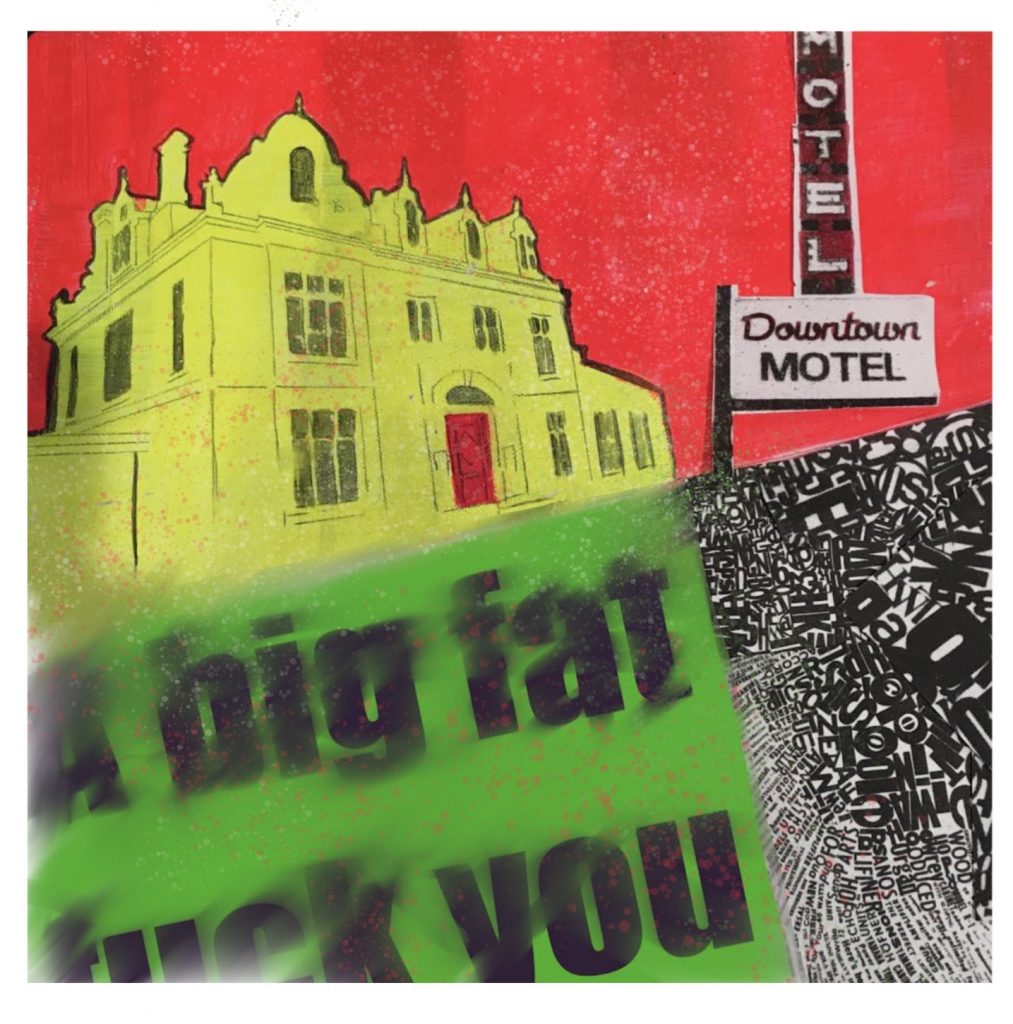
Liz Hayden | I dare you | 2022
September 24, 2023Liz Hayden | I dare you | 2022
“…the City’s refusal to support a public art gallery makes it’s endorsement of a heritage award a travesty.”
(Elizabeth Chitty)
A decade or so ago, I curated an exhibition from the archives of the now defunct (having merged into paved arts) Photographers Gallery in Saskatoon. On the accompanying panel (with artists Patrick Close, Sandra Semchuck and Doug Townsend, whom all had played seminal roles with the gallery as well as organizations like CARFAC and the Saskatchewan Arts Board) I made the observation that communities will create images of themselves that more accurately reflect the reality of the place, often when confronted with depictions that are not just disconnected from lived experience but in direct opposition to reality.
Liz Hayden’s image has been in my mind since she first shared it on social media some time ago : Hayden has been a vocal ally during the travails here in calling out the lies and self aggrandizing ignorance that has defined Brock University’s ‘demolition through neglect’ (to quote a past Cultural Coordinator for the city of St. Catharines) and sale of Rodman Hall Arts Centre, and the City of St. Catharines’ weathervaning between apathy and self congratulatory dishonesty.
The latest chapter in the travesty that is the City of St. Catharines’ apathy and ignorance – which has, in that manner I should know better by now, become even more egregiously foolish – was brought to my attention earlier this week. You can read more about that here. Essentially, the city council of St. Catharines – which I sometimes less than affectionately refer to as ‘North Welland’, to remind them that the delusion that STC is the ‘jewel’ of Niagara is a transparent lie to many of us in the cultural milieu – is seeking provincial heritage designation for the former gallery site, though it’s nothing more than a boutique hotel now, and all the things that made it an important site are now lost…
This is nothing more than STC Council giving an award to someone who has helped the local political cowards, miscreants, liars and ignorant incompetents NOT have to deal with the fact that the gallery may have been bulldozed and the subsequent critiques that would then expose their absence on the loss of the gallery and the harm this caused to the cultural community.
We used to have a nationally recognized and lauded art gallery, a centre for cultural and community oriented groups and now it’s just a ’boutique hotel’ and this merits recognition? This is an affront, especially considering the lackadaisical disinterest of the previous mayor and the inaction of many supposed ‘stakeholders.’
Did I mention that the city of St. Catharines has made some rumblings about wanting to have a ‘cultural renaissance’ in the city? Some things I cannot make up.
But now that I have set the stage with that intersecting rant, let us consider Liz Hayden’s artwork that speaks to these ideas. When we were speaking about it recently, she made the comment of ‘angry colours, wasted words.’
This work by Liz Hayden is titled I dare you : and I suspect that is a title that dares the viewer, but also those whom might be ‘offended’ by what the work states, to attempt to defend what has been allowed to happen, so their ignorance might be exposed. This is – like much of my writing and advocacy on the subject – perhps tilting at windmills : a recent ‘conversation’ on the Niagara History social media page was rife with people ‘excited’ at the new hotel, ignoring that access to the grounds would be limited, that a community focal point was gone, that citizens were irrelevant next to a few consumers and that this is a superficial facade that is a shoddy cover for what was an award winning artistic space that was deeply important to many.
These are some of the words that Hayden included to accompany another work in this series (which can be seen in the full post), but they are relevant here, as well :
Show me your garden and I shall tell you what you are. (Alfred Austin)
He is the gardener.
There at daybreak, he tills and waters: nurturing the plants, the community. Open-handed, he shares hard-gained knowledge and his harvest. Here is a place to heal, to grow. Free, in the air, without fear.
He is the gardener.
He walks the park, picking up.
Greets the old ladies, and their dogs, by name
A smile, the weather.
The garden is his purpose.
He toils there and grows
Himself and all of us
In that earth
This is one of a series of garden portraits I completed in 2022 focusing on gardens and gardeners here in St. Catharines, the Garden City. This acrylic on canvas portrays Richard Pierpont park, (previously known as Centennial Gardens) and Ross Hayden who has gardened there since the inception of those public gardens approximately 10 years ago.
A garden is a fine metaphor for a community : and there are many who are as insulted by the council’s proposal in terms of the loss of the green space as much as the artistic space. I will admit that I am also reminded of Oscar Wilde’s story about The Selfish Giant, but that one, at least, has a happy ending : but the giant had some introspection and that cannot be said for St. Catharine’s political ‘leaders’, on this front….
~ Bart Gazzola
Read More
Recent Comments